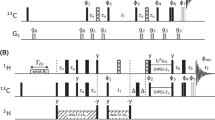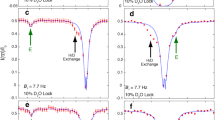Abstract
Chemical Exchange Saturation Transfer (CEST) is an MRI approach that can indirectly detect exchange broadened protons that are invisible in traditional NMR spectra. We modified the CEST pulse sequence for use on high-resolution spectrometers and developed a quantitative approach for measuring exchange rates based upon CEST spectra. This new methodology was applied to the rapidly exchanging Hδ1 and Hε2 protons of His57 in the catalytic triad of bovine chymotrypsinogen-A (bCT-A). CEST enabled observation of Hε2 at neutral pH values, and also allowed measurement of solvent exchange rates for His57-Hδ1 and His57-Hε2 across a wide pH range (3–10). Hδ1 exchange was only dependent upon the charge state of the His57 (k ex,Im+ = 470 s−1, k ex,Im = 50 s−1), while Hε2 exchange was found to be catalyzed by hydroxide ion and phosphate base (\( k_{{{\text{OH}}^{ - } }} \) = 1.7 × 1010 M−1 s−1, \( k_{{{\text{HPO}}_{4}^{2 - } }} \) = 1.7 × 106 M−1 s−1), reflecting its greater exposure to solute catalysts. Concomitant with the disappearance of the Hε2 signal as the pH was increased above its pK a, was the appearance of a novel signal (δ = 12 ppm), which we assigned to Hγ of the nearby Ser195 nucleophile, that is hydrogen bonded to Nε2 of neutral His57. The chemical shift of Hγ is about 7 ppm downfield from a typical hydroxyl proton, suggesting a highly polarized O–Hγ bond. The significant alkoxide character of Oγ indicates that Ser195 is preactivated for nucleophilic attack before substrate binding. CEST should be generally useful for mechanistic investigations of many enzymes with labile protons involved in active site chemistry.






Similar content being viewed by others
Notes
pK w is an estimated value at 4°C as described in “Materials and methods”.
The proton with a chemical shift of 12 ppm at basic pH values must exchange rapidly with solvent to be detected by the CEST method, indicating that the proton is bound to a heteroatom. The 12 ppm chemical shift falls in the chemical shift region highly characteristic of a nitrogen bound proton in a neutral histidine side chain. bCT-A has only two histidine residues, His57 and His40. The nitrogen bound protons of His57 are assigned and His40 has a pK a of 4.6, showing no other transitions or changes with increasing pH (Markley and Ibanez 1978). The 12 ppm signal could not belong to a His residue, thus, by process of elimination we assign this shift to a shared proton between Ser195-Oγ and His57-Nε2.
The pK a of HPO4 2− at 4°C is estimated as described in “Materials and methods”.
References
Aime S, Castelli DD, Crich SG, Gianolio E, Terreno E (2009) Pushing the sensitivity envelope of lanthanide-based magnetic resonance imaging (MRI) contrast agents for molecular imaging applications. Acc Chem Res 42:822–831
Bachovchin W (1986) 15 N NMR spectroscopy of hydrogen-bonding interactions in the active site of serine proteases: evidence for a moving histidine mechanism. Biochemistry 25:7751–7759
Bachovchin W (2001) Review: contributions of NMR spectroscopy to the study of hydrogen bonds in serine protease active sites. Magn Res Chem 39:S199–S213
Barksdale A, Rosenberg A (1982) Acquisition and interpretation of hydrogen exchange data from peptides, polymers, and proteins. In: Glick D (ed) Methods of biochemical analysis, vol 28. Wiley, Hoboken, pp 1–113
Bruice T, Fife T, Bruno J, Brandon N (1962) Hydroxyl group catalysis. II. The reactivity of the hydroxyl group of serine. The nucleophilicity of alcohols and the ease of hydrolysis of their acetyl esters as related to their pKa. Biochemistry 1:7–12
Bryant R (1996) The dynamics of water-protein interactions. Annu Rev Biophys Biomol Struct 25:29–53
Christensen J, Hansen L, Izatt R (1976) Handbook of proton ionization heats and related thermodynamic quantities. Wiley, New York
Dery O, Corvera C, Steinhoff M, Bunnett N (1998) Proteinase-activated receptors: novel mechanisms of signaling by serine proteases. Am J Physiol Cell Physiol 274:C1429–C1452
Eigen M (1964) Proton transfer, acid-base catalysis, and enzymatic hydrolysis. Part I: elementary processes. Angew Chem Int Ed Engl 3:1–19
Eigen M, Hammes G, Kustin K (1960) Fast reactions of imidazole studied with relaxation spectrometry. J Am Chem Soc 82:3482–3483
Forsén S, Hoffman RA (1963) Study of moderetely rapid chemical exchange by means of nuclear magnetic double resonance. J Chem Phys 39:2892–2901
Freer S, Kraut J, Robertus J, Wright H (1970) Chymotrypsinogen: 2,5-crystal structure, comparison with -chymotrypsin, and implications for zymogen activation. Biochemistry 9:1997–2009
Friedman J, McMahon M, Stivers J, Van Zijl P (2010) Indirect detection of labile solute proton spectra via the water signal using frequency-labeled exchange (FLEX) transfer. J Am Chem Soc 132:1813–1815
Gasteiger E, Gattiker A, Hoogland C, Ivanyi I, Appel R, Bairoch A (2003) ExPASy: the proteomics server for in-depth protein knowledge and analysis. Nucleic Acids Res 31:3784–3788
Gilli P, Bertolasi V, Pretto L, Gilli G (2006) Outline of a transition-state hydrogen-bond theory. J Mol Struct 790:40–49
Goffeney N, Bulte JW, Duyn J, Bryant LH Jr, van Zijl PC (2001) Sensitive NMR detection of cationic-polymer-based gene delivery systems using saturation transfer via proton exchange. J Am Chem Soc 123:8628–8629
Grad J, Bryant R (1990) Nuclear magnetic cross-relaxation spectroscopy. J Magn Reson 90:1–8
Gregory R, Crabo L, Percy A, Rosenberg A (1983) Water catalysis of peptide hydrogen isotope exchange. Biochemistry 22:910–917
Hedstrom L (2002) Serine protease mechanism and specificity. Chem Rev 102:4501–4524
Heutinck K, ten Berge I, Hack C, Hamann J, Rowshani A (2010) Serine proteases of the human immune system in health and disease. Mol Immunol 47:1943–1955
Holz M, Heil S, Sacco A (2000) Temperature-dependent self-diffusion coefficients of water and six selected molecular liquids for calibration in accurate 1 H NMR PFG measurements. Phys Chem Chem Phys 2:4740–4742
Kerr M, Walsh K, Neurath H (1975) Catalysis by serine proteases and their zymogens. Study of acyl intermediates by circular dichroism. Biochemistry 14:5088–5094
Kossiakoff A, Spencer S (1981) Direct determination of the protonation states of aspartic acid-102 and histidine-57 in the tetrahedral intermediate of the serine proteases: neutron structure of trypsin. Biochemistry 20:6462–6474
Kraut J (1977) Serine proteases: structure and mechanism of catalysis. Annu Rev Biochem 46:331–358
Liang T, Abeles R (1987) Complex of α-chymotrypsin and N-acetyl-l-leucyl-l-phenylalanyl trifluoromethyl ketone: structural studies with NMR spectroscopy. Biochemistry 26:7603–7608
Ling W, Regatte RR, Navon G, Jerschow A (2008) Assessment of glycosaminoglycan concentration in vivo by chemical exchange-dependent saturation transfer (gagCEST). Proc Natl Acad Sci USA 105:2266–2270
Lonsdale-Eccles J, Neurath H, Walsh K (1978) Probes of the mechanism of zymogen catalysis. Biochemistry 17:2805–2809
Markley J, Ibanez I (1978) Zymogen activation in serine proteinases. Proton magnetic resonance pH titration studies of the two histidines of bovine chymotrypsinogen A and chymotrypsin A. alpha. Biochemistry 17:4627–4640
Markley J, Westler W (1996) Protonation-state dependence of hydrogen bond strengths and exchange rates in a serine protease catalytic triad: bovine chymotrypsinogen A. Biochemistry 35:11092–11097
McMahon MT, Gilad AA, Zhou J, Sun PZ, Bulte JWM, van Zijl P (2006) Quantifying exchange rates in chemical exchange saturation transfer agents using the saturation time and saturation power dependencies of the magnetization transfer effect on the magnetic resonance imaging signal (QUEST and QUESP): Ph calibration for poly L lysine and a starburst dendrimer. Magn Reson Med 55:836–847
McMahon MT, Gilad AA, DeLiso MA, Berman SM, Bulte JW, van Zijl PC (2008) New “multicolor” polypeptide diamagnetic chemical exchange saturation transfer (DIACEST) contrast agents for MRI. Magn Reson Med 60:803–812
Morgan P, Robinson N, Walsh K, Neurath H (1972) Inactivation of bovine trypsinogen and chymotrypsinogen by diisopropylphosphorofluoridate. Proc Natl Acad Sci USA 69:3312–3316
Mulkern RV, Williams ML (1993) The general solution to the Bloch equation with constant RF and relaxation terms: application to saturation and slice selection. Med Phys 20:5–13
Polgar L (2005) The catalytic triad of serine peptidases. Cell Mol Life Sci 62:2161–2172
Proskuryakov M (1967) Preparation and some properties of porcine chymotrypsinogen. Chem Nat Compd 3:38–40
Raiford D, Fisk C, Becker E (1979) Calibration of methanol and ethylene glycol nuclear magnetic resonance thermometers. Anal Chem 51:2050–2051
Rawlings N, Barrett A (2010) MEROPS: the peptidase database. Nucleic Acids Res 38:D227–D233
Robillard G, Shulman R (1972) High resolution nuclear magnetic resonance study of the histidine–aspartate hydrogen bond in chymotrypsin and chymotrypsinogen. J Mol Biol 71:507–511
Robillard G, Shulman R (1974a) high resolution nuclear magnetic resonance studies of the active site of chymotrypsin. J Mol Biol 86:519–540
Robillard G, Shulman R (1974b) High resolution nuclear magnetic resonance studies of the active site of chymotrypsin. II. Polarization of histidine 57 by substrate analogues and competitive inhibitors. J Mol Biol 86:541–558
Sherry AD, Woods M (2008) Chemical exchange saturation transfer contrast agents for magnetic resonance imaging. Annu Rev Biomed Eng 10:391–411
Slutsky L, Madsen L, White R, Harkness J (1980) Kinetics of the exchange of protons between hydrogen phosphate ions and a histidyl residue. J Phys Chem 84:1325–1329
Tung M, Steiner R (1974) The self-association of chymotrypsinogen A. Eur J Biochem 44:49–58
Ulrich E, Akutsu H, Doreleijers J, Harano Y, Ioannidis Y, Lin J, Livny M, Mading S, Maziuk D, Miller Z (2008) BioMagResBank. Nucleic Acids Res 36(Database issue):D402–D408
van Beek J (2007) matNMR: a flexible toolbox for processing, analyzing and visualizing magnetic resonance data in Matlab®. J Magn Reson 187:19–26
van Zijl P, Moonen C (1992) Solvent suppression strategies for in vivo magnetic resonance spectroscopy. In: Seelig J, Ruden M (eds) NMR, basic principles and progress, vol 26. Springer, Berlin, pp 67–108
van Zijl PCM, Yadav N (2011) Chemical exchange saturation transfer (CEST): what is in a name and what isn’t? Magn Reson Med 65:927–948
Viragh C, Harris T, Reddy P, Massiah M, Mildvan A, Kovach I (2000) NMR evidence for a short, strong hydrogen bond at the active site of a cholinesterase. Biochemistry 39:16200–16205
Wang D, Bode W, Huber R (1985) Bovine chymotrypsinogen A: X-ray crystal structure analysis and refinement of a new crystal form at 1.8 Å resolution. J Mol Biol 185:595–624
Ward KM, Aletras AH, Balaban RS (2000) A new class of contrast agents for MRI based on proton chemical exchange dependent saturation transfer (CEST). J Magn Reson 143:79–87
Wishart DS, Bigam CG, Yao J, Abildgaard F, Dyson HJ, Oldfield E, Markley JL, Sykes BD (1995) 1H, 13C and 15 N chemical shift referencing in biomolecular NMR. J Biomol NMR 6:135–140
Wüthrich K (1986) NMR of proteins and nucleic acids. Baker Lecture series. Wiley, New York
Yoshida S, Shiosaka S (1999) Plasticity-related serine proteases in the brain (review). Int J Mol Med 3:405–409
Zhao Q, Abeygunawardana C, Gittis A, Mildvan A (1997) Hydrogen bonding at the active site of [delta] 5–3-ketosteroid isomerase. Biochemistry 36:14616–14626
Zhou J, Wilson D, Sun P, Klaus J, van Zijl P (2004) Quantitative description of proton exchange processes between water and endogenous and exogenous agents for WEX, CEST, and APT experiments. Magn Reson Med 51:945–952
Acknowledgments
We thank Dr. David Shortle for suggesting the application of CEST to the catalytic triad and helpful discussions. We thank Dr. Juliette Lecomte and Dr. Al Mildvan for insightful discussions. We thank Dr. Mike McMahon for providing the QUEST numerical simulation program with the Bloch equations. We thank Dr. Bennett Landman for programming assistance and data processing consultation. We thank Dr. Ananya Majumdar, Dr. Douglas Robinson, and Joshua Friedman for experimental assistance. This work was supported in part by NIH grant GM068626 to J.T.S.
Author information
Authors and Affiliations
Corresponding author
Electronic supplementary material
Below is the link to the electronic supplementary material.
Rights and permissions
About this article
Cite this article
Lauzon, C.B., van Zijl, P. & Stivers, J.T. Using the water signal to detect invisible exchanging protons in the catalytic triad of a serine protease. J Biomol NMR 50, 299–314 (2011). https://doi.org/10.1007/s10858-011-9527-z
Received:
Accepted:
Published:
Issue Date:
DOI: https://doi.org/10.1007/s10858-011-9527-z




